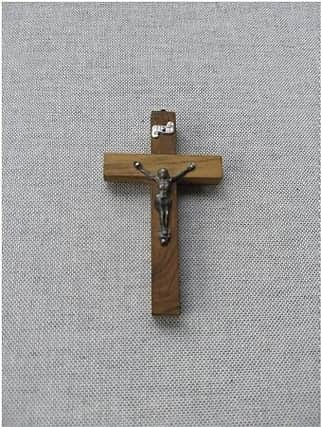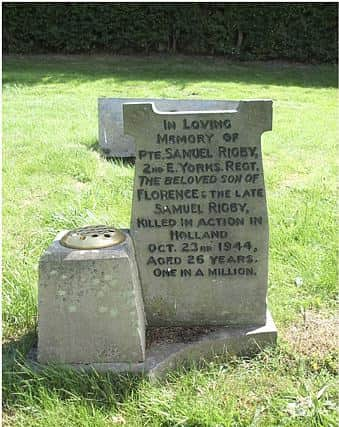The tragic story of soldier Sam and a crucifix


WHEN soldier Samuel Rigby found a wooden crucifix in a ruined house in the Netherlands, he hoped it would be a talisman to keep him safe from harm.
But after he and his platoon left the family they were staying with and went on patrol without it, the infantryman was shot by a sniper and died aged just 26.
Advertisement
Hide AdAdvertisement
Hide AdHis grieving comrades decided their distraught hostess should keep the cross - but her relatives are now determined Pte Rigby’s family should have it.
Pte Rigby, originally from Holmes, is believed to have found the cross in a deserted house in the shattered village of Overloon during 1944, only a few days before he died.
Dutchman Mart Janssen, with whose family Pte Rigby and his comrades stayed related how Pte Rigby and seven brothers in arms from the East Yorkshire Regiment were quartered with himself and his family in the town of Venray in October 1944.


Mart (81), who was aged just five at the time, said: “The first event in the war I can remember is that on a sunny Sunday morning in August 1944, hundreds of British and American planes came over on the way to the Ruhr area in Germany.
Advertisement
Hide AdAdvertisement
Hide Ad“Suddenly, most of the planes threw out an enormous amount of silver, aluminium paper, to mislead the German radar equipment.
“All that paper blinking in the sun was, for us children, a miracle, which we looked to open mouthed.
“The next event was the beginning, at the end of September, of the battle of Overloon-Venray.
“(It was) a terrible battle and we as inhabitants were obliged to stay in the cellar during the whole day, for weeks.”
Advertisement
Hide AdAdvertisement
Hide AdDuring this period, a platoon from the Second Battalion of the East Yorkshire Regiment was quartered with the Janssens.
Among them were Ptes Rigby and Lionel Roebuck, who had only recently been deployed to join the platoon, which had been on the continent since landing in Normandy four months earlier.
Pte Rigby had been transferred from the Duke of Wellington’s Regiment to the East Yorkshire Regiment, while Pte Roebuck had returned to France after having been wounded and sent home to recover.
When Mr Roebuck recorded his war memoirs in 1993 as part of the Imperial War Museum’s oral history of the conflict, he recalled how, on their way from Wanroy to Venray, the soldiers had passed the ruined village of Overloon.
Advertisement
Hide AdAdvertisement
Hide AdHere, Pte Rigby, whom Mr Roebuck said was “a good looking lad”, with curly hair, had found the wooden crucifix, telling his comrades: “As long as I have this cross with me, nothing can happen to me.”
But Mart said just days later events had taken a tragic turn when the platoon went on patrol nearby, leaving behind everything but their weapons.
“They left our home with eight and came back with seven some hours later,” he said.
“Samuel was shot by a German sniper in the head and died immediately.
Advertisement
Hide AdAdvertisement
Hide Ad“When they came back, the soldiers told my parents what had happened and discovered that the wooden crucifix was still in Samuel’s luggage.
“At that moment, according to Lionel’s story, my mother was in shock and crying heavily.
“Then they (the soldiers) decided together to give the wooden crucifix to my mother.”
The Janssens, who were ordered to evacuate the town two days later, ensured Pte Rigby’s death was not forgotten, holding a remembrance service for many years at the spot where he was buried.
Advertisement
Hide AdAdvertisement
Hide Ad“Every year, I stood before the grave of Samuel and laid down some flowers,” recalled Mart, who now lives in the Dutch town of Heelsum.
Mart and his wife Jeanne showed their family’s gratitude to the Allied soldiers in 2018 with a pilgrimage from their home town to Venray.
The couple, who regularly host veterans as part of the annual remembrance commemorations, said the trek had been “a homage for all the innocent victims of the Second World War –– independent of their nationality”.
The Janssens, who were both then aged almost 80, walked the 150 miles with 10kgs of luggage each, passing the German cemetery where 32,500 soldiers were buried, en route.
Advertisement
Hide AdAdvertisement
Hide Ad“It was sometimes very heavy, but we did it with a smile on our faces,” said Mart.
Then, last autumn, the crucifix found by Pte Rigby turned up at Mart’s younger brother’s home, sparking the family’s search for relatives of Pte Rigby to pass it on to them.
Mart added: “When my mother got the crucifix from Roebuck and his comrades, she was happy to have it.
“But years after the war, she told me sometimes: ‘The crucifix doesn’t belong to me, it belongs to the relatives of Samuel’.
Advertisement
Hide AdAdvertisement
Hide Ad“At that time, the possibilities were not so many as today, with email and internet and so on.
“When I heard last year that the crucifix had been found, I thought immediately I would do my best to find relatives of Samuel.”
The three-inch cross has a wax seal on the back and the words: “Ex olivis Gethsemane”, suggesting it contained wood from the garden of Gethsemane in Jerusalem.
Mart said he had been able to compile a few details of Pte Rigby’s background and service record, including his service number of 4616920 and that he was the son of Samuel and Florence Ada Rigby, of Holmes.
Advertisement
Hide AdAdvertisement
Hide AdThe family have also found a drawing (above) of Pte Rigby, as well as a photo of a memorial stone at Masbrough Cemetery, on the FindAGrave website.
Mr Roebuck said in his oral account that he had returned to the Netherlands in 1976 and tracked down Mart’s mother, who’d offered the cross to him –– but he had told her to keep it.
Now the Janssens are keen for the crucifix to go to a descendant of Pte Rigby.
If you are a descendant of Pte Samuel Rigby, please drop us a line at [email protected] or call 01709 803561.